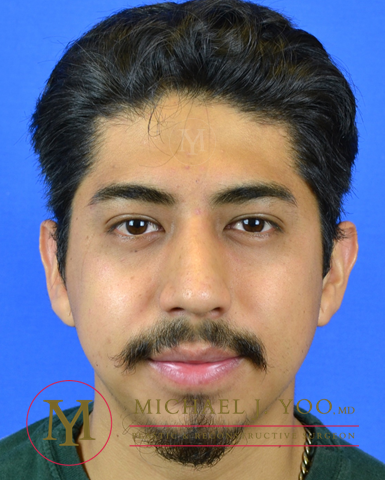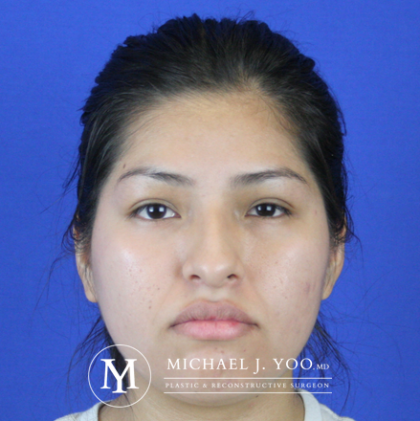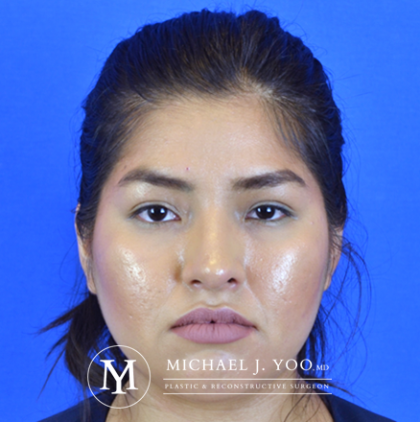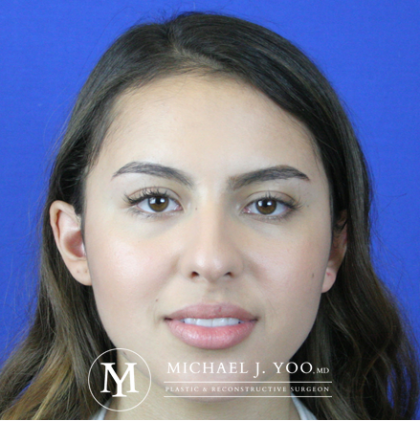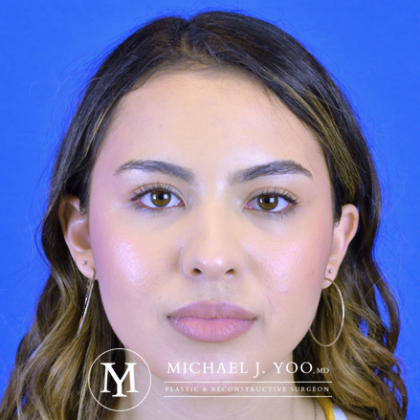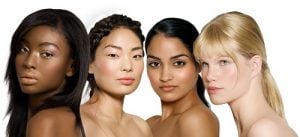
Ethnic rhinoplasty is a surgical procedure to enhance the nose in a way that integrates seamlessly with the patient’s natural facial features. Cosmetic surgery should always celebrate a person’s ethnicity and heritage.
Contents
- 1 Natural Beauty Is Not One-Size-Fits-All
- 2 About Ethnic Rhinoplasty in LA and Orange County
- 3 Before and After Photos
- 4 Benefits
- 5 Good Candidates
- 6 Your Consultation in Orange County or Beverly Hills
- 7 Preparation
- 8 Procedure Options
- 9 What to Expect During Recovery
- 10 Natural-Looking Results
- 11 Additional Procedures
- 12 How Much Is Ethnic Rhinoplasty in LA and Orange County?
- 13 FAQ
- 14 References
Natural Beauty Is Not One-Size-Fits-All
Are you considering nose surgery but concerned about whether the result will look natural? The nose is one of the most prominent features on our face. It’s also very obvious when a patient has a “nose job” that doesn’t harmonize with their natural ethnic facial features. For patients from a variety of ethnic heritages, the surgeon must understand the nuances required to perform natural-looking and beautiful rhinoplasty. Otherwise, the result will appear obvious and overly “done”. No one wants a nose out of sync with the rest of the face.
In the United States, most plastic surgeons trained in rhinoplasty perform one rhinoplasty technique used for all ethnicities. Michael J. Yoo, M.D., however, is skilled in utilizing traditional rhinoplasty techniques and also in performing various types of ethnic rhinoplasty, including African American rhinoplasty, Asian rhinoplasty, Hispanic rhinoplasty, and more. Ethnic rhinoplasty requires technical skill, aesthetic artistry, and broad knowledge of different ethnic anatomies. Open a dialogue with Dr. Yoo by filling out the online contact form or calling the office.
For Orange County, please call (949) 861-3340
For Beverly Hills, please call (424) 209-9925
About Ethnic Rhinoplasty in LA and Orange County
Nose surgery is one of the most delicate and aesthetically complex procedures in cosmetic surgery. When someone has had rhinoplasty and the nose doesn’t match the rest of the face, everyone notices. Noses can’t be picked off a shelf and plucked onto your face. The result of rhinoplasty has to blend seamlessly with your facial features and look completely natural for your inner beauty to shine. If you are of non-Caucasian ethnicity and considering rhinoplasty, Dr. Yoo understands how to preserve the characteristics of your ethnicity and facial features.
What Does Ethnic Rhinoplasty Mean?
Ethnic rhinoplasty means nose surgery performed on patients of non-Caucasian ethnicity. Ethnic rhinoplasty aims to enhance the appearance of the nose without jeopardizing your unique ethnic identity. Ethnic rhinoplasties require a great amount of experience and knowledge of the face as a whole, and how it relates directly to the ethnicity of the patient. Dr. Yoo always aims to refine a nose using techniques that facilitate symmetry and proportion.
Before and After Photos
Benefits
- Harmonize facial features
- Enhance the natural features of the face
- Correct structural abnormalities
- Balance facial features with greater symmetry
- Restore youthful beauty while celebrating your heritage and cultural history
Good Candidates
People of all ethnic backgrounds can be candidates so long as they are healthy and have realistic expectations. While there is no one singular technique that can be applied to people of a given background, there are general guidelines that can be used to advise the surgeon when determining the proper techniques to address the patient’s concerns. In order to develop a strategic plan, Dr. Yoo meets with new patients for a private consultation. During the consultation, he will analyze the patient’s unique nasal and facial features and answer any questions.
Your Consultation in Orange County or Beverly Hills
Communication is vital to Dr. Yoo. During your private consultation, he will get to know you as a person. In ethnic rhinoplasty, understanding your aesthetic goals is just as important as reviewing your medical history. An open dialogue of communication becomes extremely important to ensure the surgeon and patient are on the same page. The nose that looks great on a Hollywood actress might completely unbalance your face. When selecting a plastic surgeon for ethnic rhinoplasty, find a surgeon that understands the nuances of different ethnic features and has the expertise to reconstruct a nose that best matches those features.
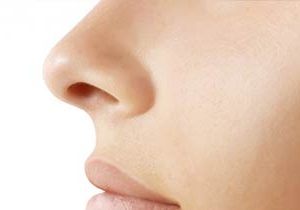
Dr. Yoo is double Board-Certified by the American Board of Plastic and Reconstructive Surgery and the American Board of Otolaryngology (Head and Neck Surgery). He trained at the world-renowned Cleveland Clinic and earned a first-place prize at the Annual Meeting of the American Society of Reconstructive Microsurgery. To continually expand his knowledge, he visits plastic surgery centers in both the United States and Seoul, South Korea to remain up to date on the latest research and innovations.
Dr. Yoo feels grateful for all his patients and appreciates any patient that honors him by sending a note or leaving a review. Begin a conversation with Dr. Yoo by contacting his offices online or calling.
In Orange County: (949) 861-3340
In Beverly Hills: (424) 209-9925
Virtual consultations are now available to best suit your schedule and lifestyle. You can stay informed about recent plastic surgery news by following Dr. Yoo’s blog.
Preparation
It’s important to follow any and all instructions provided by Dr. Yoo and his team of medical professionals. Please stop smoking if you are a smoker. Smoking increases the risk of complications. Do not take blood-thinning medication such as aspirin and ibuprofen in the week before surgery.
Procedure Options
While there are many variations of ethnic rhinoplasty, below are the most commonly performed variations. Facial features vary from person to person, so Dr. Yoo tailors each rhinoplasty to the individual. To learn more about ethnic rhinoplasty techniques, please do not hesitate to contact our office to schedule a consultation with Dr. Yoo.
African American Rhinoplasty
African American Rhinoplasty is typically performed on people descended from the predominantly Black regions of Africa. However, a great deal of diversity exists between these different regions. Central Africa, West Africa, and East Africa all have their own distinct characteristics. In general, African American noses have low nasal bridges and wide tips and nostrils. With these features, African American rhinoplasty often involves nasal implants, cartilage grafts, and alar wedge excisions.
Asian Rhinoplasty
Asian Rhinoplasty is commonly performed on people of Chinese, Vietnamese, Korean, and Filipino descent, but can be performed on men and women of any Asian descent. Asian patients tend to have thick nasal skin, a wide nasal tip that points upward, shorter nasal bones, and a depressed bridge. Taking these traits into account, Asian rhinoplasty often involves adding cartilage to the nose to create a straighter bridge and add support, lowering of the nostrils, thinning the skin, and increasing the projection of the tip.
Latin and Hispanic Rhinoplasty
Hispanic Rhinoplasty is usually performed on people of Latin American or Iberian ancestry. Hispanic patients commonly have thick nasal skin, an undefined nasal bridge, a flat nasal tip, and wide nostrils. With this, Hispanic rhinoplasty often involves using grafting material on the bridge and tip and performing an alar wedge excision technique.
Persian and Middle Eastern Rhinoplasty
Some common methods in Persian and Middle Eastern Rhinoplasty include correcting a crooked nose, a dorsal hump (bump on the bridge of the nose), a bulbous tip, and a nose that appears too long or wide for the face. Middle eastern and Persian rhinoplasty seeks to harmonize the nose with other facial features by balancing the size and shape with the overall face.
What to Expect During Recovery

Patients should make sure they’ve appointed someone to drive them home after surgery. Dr. Yoo also recommends a caregiver stay the night to help with any tasks. Minor swelling and mild bruising are normal after surgery. Patients should use ice or a cold compress to reduce any swelling and bruising. Patients will wear a nose splint for 5-7 days after surgery. Sleep with the head elevated and use pillows to cradle the neck to minimize the possibility of rolling over onto the nose. Many patients prefer to take a week or two off work to allow the nose to heal under the most relaxed and comfortable conditions. Avoid any strenuous activity for about 6 weeks after surgery. It’s also important to avoid any activity that might impact the nose during the recovery period.
Natural-Looking Results
Once the swelling subsides and your body starts to heal, you’ll begin to notice your initial results during the first two months of healing. However, it may take a year to 18 months for your new nasal contours to fully develop. The benefit of rhinoplasty is that the natural-looking results can last a lifetime.
Additional Procedures
Rhinoplasty naturally complements septoplasty. Septoplasty is surgery to reconstruct a damaged or deviated septum. Because both procedures reconstruct nasal cartilage, they can be performed simultaneously.
How Much Is Ethnic Rhinoplasty in LA and Orange County?
In Los Angeles and Orange County, the price can range from $3,000 to $15,000. Due to the intricate nature of ethnic rhinoplasty, the prices will vary from patient to patient depending on what the procedure requires. After discussing your desires, reviewing your medical history, and going over expectations, Dr. Yoo can quote you a price for the procedure. Visit the pricing page for more information.
FAQ
How long will the results last?
Rhinoplasty constitutes a permanent change to the nasal structure. The results will last the rest of your life with the caveat that rhinoplasty does not stop the natural aging process. Both standard aging and photoaging (effects of the sun over time) can affect the appearance of your new nose just like they do any nose.
References
- Saad, A., Hewett, S., Nolte, M. et al. (2018). Ethnic Rhinoplasty in Female Patients: The Neoclassical Canons Revisited. Aesthetic Plastic Surgery. 42, 565–576 https://doi.org/10.1007/s00266-017-1051-4
- Pourdanesh, F., Tabrizi, R., Vahedi, R., & Mohajerani, H. (2014). Ethnic Rhinoplasty in Iranians: The Oral and Maxillofacial Surgery Experience. Journal of Oral and Maxillofacial Surgery, 72(12). doi:10.1016/j.joms.2014.07.019
- Ishii C. H. (2014). Current update in asian rhinoplasty. Plastic and reconstructive surgery. Global open, 2(4), e133. https://doi.org/10.1097/GOX.0000000000000081
- Szychta, P., Rykała, J. & Kruk-Jeromin, J. Individual and ethnic aspects of preoperative planning for posttraumatic rhinoplasty. (2011). European Journal of Plastic Surgery. 34, 245–249 https://doi.org/10.1007/s00238-010-0502-9

